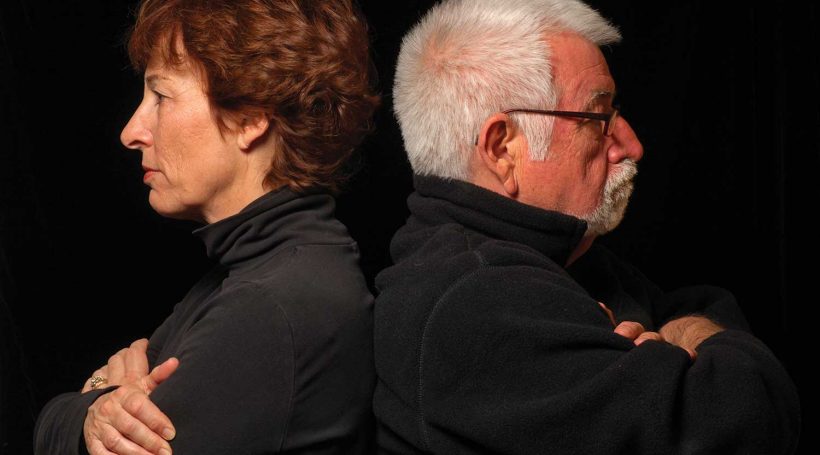Louise Martin’s* heart was never in her marriage. Her heart had been left with her college sweetheart years earlier. She swears that longing led to her divorce after almost 25 years of marriage, when she was 55.
“I believe it was a difference in our personalities. My ex-husband was kind of old-fashioned and controlling, and I’m a strong woman. My heart wasn’t healed from that first relationship,” says the lifelong Camden County resident. “As we grew together, although there was a friendship, it was more like being a sister and a brother than being married. I didn’t have fulfillment.”
As with many divorces, several factors were at play. Besides the personality clashes and distracted feelings, Martin’s husband was spending more and more time with a female friend. But the relationship reached its breaking point when the couple’s adult son died in a car accident. The two separated for almost 10 years. Eventually Martin’s husband wanted to permanently dissolve their union, but she resisted – much to her own surprise.
“I never said I wanted a divorce. I wanted him to move away with me,” she says. “I thought staying married was the right thing to do, but who knows?”
She calls the years following her divorce “a nightmare on top of a nightmare on top of a nightmare,” full of financial uncertainty and health woes. Martin says she is happy post-divorce, but another challenge is looming.
“I travel. I swim every day. Now what I’m going through is, ‘What else do I want to do?’” she says.
Feelings of being adrift, as well as empowered, can face anyone following a divorce, but Martin is in a burgeoning group. Divorces between those with decades of marriage behind them are on the upswing. The reasons for these conscious break-ups vary, but the female half of the union is left to wonder what the second act will be in her remaining years.
Though overall divorce rates have leveled off, the number of divorces among those ages 50 and older has doubled, says a study from Ohio’s Bowling Green State University. In 1990, one in 10 divorces involved people age 50 and over. Now it’s one in four.
Several factors contribute to the recent phenomenon of “gray divorce,” says Rowan University sociology professor Mark Hutter.
“A hundred years ago, this was not an issue,” he says. “The predominant reason was we were not around for this to be a question. People did not live long. The most you were married was about 20 years.”
In the early 1900s, says Hutter, a woman would marry at 20 and have children, with the youngest coming of age when the mother was in her mid-40s – as she neared the end of her life. Today’s longevity means men and women are giving more consideration to the decades that follow raising a family, when the children have grown and flown.
“It’s a huge period of time that’s as long as the birthing and child-rearing years. The issue is, ‘What is this marriage all about?’” says Hutter. “You marry at 25 to someone who shares your values at that time in your life. You share a child, and marriages can revolve around the child. When that child enters college, you are living 40 more years. It becomes, ‘Do we share the same interests and involvements? Do I want my last years to be with this person?’”
The questions suddenly had more than one viable answer, with the advent of no-fault divorce in the 1970s. Couples were then able to dissolve a union easily, because they did not have to prove adultery, cruelty or other fault, says Rutgers-Camden law professor Sally Goldfarb.
“The social changes of the 1960s and ’70s led to greater pressure to make divorce more straightforward, less stigmatized and easier to achieve,” says Goldfarb. “After the adoption of no-fault divorce, the divorce rate went up because there was a pent-up demand for divorces. When it became available without proving fault, couples that had long wanted to divorce flooded the system. But pretty soon, the divorce rate began to drop. It is lower now than it was at its peak in the late 1970s.”
Childless couples, says Hutter, may not face the same changes as empty-nesters. They have been together, alone and with no outside focus, for years. Even those who marry later in life do not face the same issues.
“If you marry at 40 with no children, you will know if you want to be with that person,” says Hutter. “You don’t wait 30 years to divorce.”
Thirty years was the magic number for Dawn Lansing*. The mother of four said she suffered through her ex-husband’s abuse before their divorce in 2012. Her children, says Lansing, were the reason she stayed so long.
“He was a good provider, good to our boys. I kept my mouth shut because of the boys,” says the Burlington County resident. “We had a nice house. So we had the house, we had the kids. As long as I did everything he told me, it was OK.”
The couple dated three years before they married right out of high school at age 18. After her divorce, Lansing tries to piece together the good times that did not involve her sons.
“When we returned to New Jersey after living in another state, he got a good job. He’d shower me with gifts. He was good to me at that point,” she says. “More or less, he was my first love. Now I have no feelings for him at all.”
Lansing is left, as is Martin, with choosing her next step. Lansing went to cosmetology school, but was a few points shy of passing the exam. She thinks about bartending or working on a cruise ship or moving to Florida, though the last two options would take her away from her family. Martin is considering becoming a massage therapist. Neither one says she is seriously considering romance, but both say adapting financially has been the hardest part of life without marriage.
“Ninety percent of my marriage, he took care of me. At 50, I’m scared,” says Lansing. “Now I have to get a career, but who the heck wants to hire a 50-year-old?”
The two women share another trait Goldfarb says has become an issue for decade-plus divorcees: Each has adult children living with her. Child support for her college-age son is something Lansing and her ex legally spar over. While Martin’s son has wrapped up college, he has other reasons to stay close.
“I saw he needed to come back to go through the grieving process,” Martin says of his reaction to the death of his older brother and his parents’ marriage. “I think he came home because he didn’t get a chance to breathe.”
In general, adult children are financially dependent on their parents longer today than in the past, says Goldfarb. A divorced mature woman who is the caregiver for aging parents or disabled adult children usually absorbs the financial and time commitments of that care.
“When parents divorce, the father is less likely to continue to support adult children. These women struggle to meet the needs of their children. It can leave them financially worse off than before,” says Goldfarb. “A woman must think about her own future needs after her divorce, but also of her adult children’s.”
Men are routinely the primary earners in a household and may be the one holding a majority of the assets, says Goldfarb. They also are more likely to remarry. Fewer resources and lower likelihood of remarriage can leave the older divorced woman in a precarious position if she does not prepare carefully for the long-term, says Goldfarb.
“Women who are in their 60s, 70s and 80s are far more likely to live in poverty than men in that age range. A woman who lives alone has higher expenses than someone who shares a house. If she has been out of the workforce, her earning potential will be diminished. It can be an uphill battle for a woman to gain financial stability after a divorce. She will need to think about how to recover financially,” says Goldfarb.
When a decades-long marriage comes to an end, it is often difficult to think what will happen 40 years from that moment. But over time, the future comes into focus – as does the past.
“I don’t regret my husband. I don’t regret any of it,” says Martin. “It’s a story of a life.”
*Names have been changed








